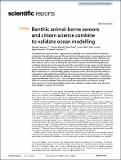Files in this item
Benthic animal-borne sensors and citizen science combine to validate ocean modelling
Item metadata
| dc.contributor.author | Lavender, Edward | |
| dc.contributor.author | Aleynik, Dmitry | |
| dc.contributor.author | Dodd, Jane | |
| dc.contributor.author | Illian, Janine | |
| dc.contributor.author | James, Mark | |
| dc.contributor.author | Smout, Sophie | |
| dc.contributor.author | Thorburn, James A. | |
| dc.date.accessioned | 2022-10-05T15:30:14Z | |
| dc.date.available | 2022-10-05T15:30:14Z | |
| dc.date.issued | 2022-10-05 | |
| dc.identifier | 281273410 | |
| dc.identifier | be38d3e1-31ee-4066-887f-95263381a787 | |
| dc.identifier | 85139278217 | |
| dc.identifier | 000864277100013 | |
| dc.identifier.citation | Lavender , E , Aleynik , D , Dodd , J , Illian , J , James , M , Smout , S & Thorburn , J A 2022 , ' Benthic animal-borne sensors and citizen science combine to validate ocean modelling ' , Scientific Reports , vol. 12 , 16613 . https://doi.org/10.1038/s41598-022-20254-z | en |
| dc.identifier.issn | 2045-2322 | |
| dc.identifier.other | ORCID: /0000-0002-7182-1725/work/120432849 | |
| dc.identifier.other | ORCID: /0000-0002-8040-7489/work/120434425 | |
| dc.identifier.uri | https://hdl.handle.net/10023/26139 | |
| dc.description | Funding: PhD Studentship at the University of St Andrews, jointly funded by NatureScot via the Marine Alliance for Science and Technology for Scotland (MASTS), and the Centre for Research into Ecological and Environmental Modelling. Data were collected as part of research funded by NatureScot (project 015960) and Marine Scotland (projects SP004 and SP02B0) via the Movement Ecology of Flapper Skate project. MASTS and Shark Guardian also provided some funding to this project. These data were made available from previous studies for this work and we have acknowledged this in the manuscript. The manuscript uses a model (WeStCOMS) whose development and expansion was supported by the EU's INTERREG VA and AA Programmes, managed by the Special EU Programmes Body via ‘Collaborative Oceanography and Monitoring for Protected Areas and Species’ (COMPASS) and ‘Predicting Risk and Impact of Harmful Events on the Aquaculture Sector’ (PRIMROSE) projects, as well as two UKRI grants: ‘Evaluating the Environmental Conditions Required for the Development of Offshore Aquaculture’ (OFF-AQUA, BB/S004246/1)’ and ‘Combining Autonomous observations and Models for Predicting and Understanding Shelf seas‘ (CAMPUS, NE/R00675X/1). | en |
| dc.description.abstract | Developments in animal electronic tagging and tracking have transformed the field of movement ecology, but interest is also growing in the contributions of tagged animals to oceanography. Animal-borne sensors can address data gaps, improve ocean model skill and support model validation, but previous studies in this area have focused almost exclusively on satellite-telemetered seabirds and seals. Here, for the first time, we develop the use of benthic species as animal oceanographers by combining archival (depth and temperature) data from animal-borne tags, passive acoustic telemetry and citizen-science mark-recapture records from 2016–17 for the Critically Endangered flapper skate (Dipturus intermedius) in Scotland. By comparing temperature observations to predictions from the West Scotland Coastal Ocean Modelling System, we quantify model skill and empirically validate an independent model update. The results from bottom-temperature and temperature-depth profile validation (5,324 observations) fill a key data gap in Scotland. For predictions in 2016, we identified a consistent warm bias (mean = 0.53 °C) but a subsequent model update reduced bias by an estimated 109% and improved model skill. This study uniquely demonstrates the use of benthic animal-borne sensors and citizen-science data for ocean model validation, broadening the range of animal oceanographers in aquatic environments. | |
| dc.format.extent | 13 | |
| dc.format.extent | 3521129 | |
| dc.language.iso | eng | |
| dc.relation.ispartof | Scientific Reports | en |
| dc.subject | QL Zoology | en |
| dc.subject | GC Oceanography | en |
| dc.subject | DAS | en |
| dc.subject | MCC | en |
| dc.subject.lcc | QL | en |
| dc.subject.lcc | GC | en |
| dc.title | Benthic animal-borne sensors and citizen science combine to validate ocean modelling | en |
| dc.type | Journal article | en |
| dc.contributor.institution | University of St Andrews. Coastal Resources Management Group | en |
| dc.contributor.institution | University of St Andrews. School of Biology | en |
| dc.contributor.institution | University of St Andrews. Marine Alliance for Science & Technology Scotland | en |
| dc.contributor.institution | University of St Andrews. Institute of Behavioural and Neural Sciences | en |
| dc.contributor.institution | University of St Andrews. Sea Mammal Research Unit | en |
| dc.contributor.institution | University of St Andrews. Scottish Oceans Institute | en |
| dc.contributor.institution | University of St Andrews. Centre for Research into Ecological & Environmental Modelling | en |
| dc.identifier.doi | https://doi.org/10.1038/s41598-022-20254-z | |
| dc.description.status | Peer reviewed | en |
This item appears in the following Collection(s)
Items in the St Andrews Research Repository are protected by copyright, with all rights reserved, unless otherwise indicated.

